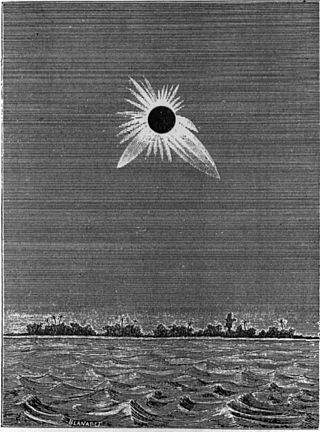| Solar eclipse of May 6, 1883 | |
|---|---|
 An artist's depiction of the total solar eclipse, observed from Caroline Atoll, Caroline Islands. | |
| Type of eclipse | |
| Nature | Total |
| Gamma | −0.425 |
| Magnitude | 1.0634 |
| Maximum eclipse | |
| Duration | 358 s (5 min 58 s) |
| Coordinates | 8°06′S 144°36′W / 8.1°S 144.6°W |
| Max. width of band | 229 km (142 mi) |
| Times (UTC) | |
| Greatest eclipse | 21:53:49 |
| References | |
| Saros | 136 (30 of 71) |
| Catalog # (SE5000) | 9241 |
A total solar eclipse occurred at the Moon's descending node of orbit between Sunday, May 6, and Monday, May 7, 1883, with a magnitude of 1.0634. A solar eclipse occurs when the Moon passes between Earth and the Sun, thereby totally or partly obscuring the image of the Sun for a viewer on Earth. A total solar eclipse occurs when the Moon's apparent diameter is larger than the Sun's, blocking all direct sunlight, turning day into darkness. Totality occurs in a narrow path across Earth's surface, with the partial solar eclipse visible over a surrounding region thousands of kilometres wide. Occurring about 1.1 days after perigee (on May 5, 1883, at 20:20 UTC), the Moon's apparent diameter was larger.[1]
The path of totality was visible from parts of the South Pacific Ocean. A partial solar eclipse was also visible for parts of eastern Australia, Oceania, Hawaii, Central America, and western South America.
- ^ "Moon Distances for London, United Kingdom, England". timeanddate. Retrieved 29 August 2024.
